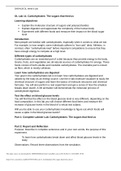Labster simulation - Study guides, Class notes & Summaries
Looking for the best study guides, study notes and summaries about Labster simulation? On this page you'll find 112 study documents about Labster simulation.
Page 4 out of 112 results
Sort by
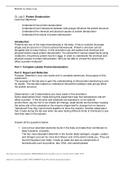
-
BIOS-251 Week 2 Lab Assignment: Protein Denaturation (Already GRADED A)
- Exam (elaborations) • 3 pages • 2022
-
Available in package deal
-
- $10.99
- + learn more
OL Lab 2: Protein Denaturation Learning Objectives: • Understand how protein denaturation. • Understand how interactions between side groups influence the protein structure • Understand th e chemical and physical causes of protein denaturation • Understand the results of protein denaturation Introduction: Proteins are one of the major biomolecules in the body. It has to maintain its proper shape and structure for it to be functional biomolecule. Protein’s structure can be disrupted due...
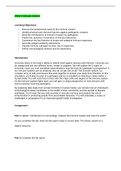
-
BIOS 255 Week 5 Immune System - Lab
- Other • 5 pages • 2022
- Available in package deal
-
- $20.49
- 1x sold
- + learn more
Learning Objectives: • Discuss the fundamental need for the immunesystem. • Identify physical and chemical barriers against pathogenicinvasion. • Describe mechanisms of immune invasion bypathogens. • Predict the outcome of scenarios of immunedeficiency. • Summarize the key features of innate and adaptive immuneresponses. • Describe antigen-antibodyinteractions. • Classify immune cell types by their role inresponses. • Define immunological memory and itsimportance. Intr...
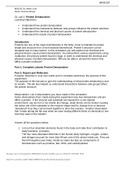
-
BIOS-251 Week 2 Lab Assignment: Protein Denaturation (Already GRADED A)
- Exam (elaborations) • 3 pages • 2022
- Available in package deal
-
- $13.99
- + learn more
OL Lab 2: Protein Denaturation Learning Objectives: Understand how protein denaturation. Understand how interactions between side groups influence the protein structure Understand the chemical and physical causes of protein denaturation Understand the results of protein denaturation Introduction: Proteins are one of the major biomolecules in the body. It has to maintain its proper shape and structure for it to be functional biomolecule. Protein’s structure can be disru...
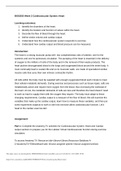
-
BIOS-255 Week 2 Assignment: The Cardiovascular System: Heart (graded)
- Exam (elaborations) • 6 pages • 2022
-
Available in package deal
-
- $10.99
- + learn more
BIOS255 Week 2 Cardiovascular System: Heart Learning outcomes: 1. Identify the chambers of the heart. 2. Identify the location and function of valves within the heart. 3. Describe the flow of blood through the heart. 4. Define stroke volume and cardiac output. 5. Understand how the cardiovascular system responds to exercise. 6. Understand how cardiac output and blood pressure can be measured. Introduction: The heart is a strong muscular pump with two complementary sets of arteries: ...
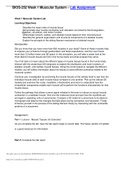
-
BIOS-252 Week 1 Muscular System – Lab Assignment (SOLVED)
- Exam (elaborations) • 5 pages • 2022
-
Available in package deal
-
- $10.99
- + learn more
BIOS-252 Week 1 Muscular System – Lab Assignment Week 1 Muscular System Lab Learning Objectives: • Describe the major roles of muscle tissue • Demonstrate how muscle contraction and rela xation are linked to thermoregulation, digestion, circulation, and motor function. • Differentiate smooth, cardiac, and skeletal muscle based on their microstructure. • Describe the general organization and structural components of a skeletal muscle. • Explain the principle of the sliding filament me...

-
CHEM 120 OL Lab 6: Solution Preparation: From salt to solution
- Exam (elaborations) • 2 pages • 2022
-
- $12.49
- 1x sold
- + learn more
CHEM 120 OL Lab 6: Solution Preparation: From salt to solution Part 1: Complete the Labster Lab: Solution Preparation: From salt to solution 1. Which equation do we need to find out how many moles of NH4Cl would there be in 500 ml of a .300 M solution of it? n= CxV 2. How do we then get from moles (n) to mass (m)? m=nxM 3. What was the first step of using the balance before adding anything to a weighing dish? Tare the balance with the weighing dish and the balance closed 4. Why is it that t...

-
Chem 120 OL Lab 6: Solution Preparation: From salt to solution
- Exam (elaborations) • 3 pages • 2023
-
- $8.99
- + learn more
Learning Objectives: Prepare an aqueous solution of a specific concentration from a pure salt Correctly use an analytical balance, a volumetric pipette, a volumetric flask, and a measuring cylinder Explain the relationship between molarity and mass concentration Introduction Prepare to become a solution champion! In this simulation, you will complete all the steps involved in preparing an aqueous solution of a given molarity from ammonium chloride – a water-soluble salt. Use that balance...
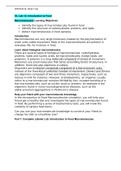
-
CHEM 120 Week 7 Lab; OL Lab 12; Introduction to Food Macromolecules
- Exam (elaborations) • 4 pages • 2021
-
- $17.49
- 2x sold
- + learn more
OL Lab 12: Introduction to Food Macromolecules Learning Objectives • Identify the types of macromolecules found in food • Identify the structure of carbohydrates, proteins, and lipids • Detect macromolecules in food samples Introduction Macromolecules are very large molecules created by the polymerization of small units called monomers. Most of the macromolecules are present in everyday life, for instance in food. Learn about biological macromolecules There are several types of biol...
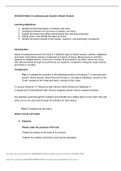
-
BIOS-255 Week 3 Assignment: Cardiovascular System: Blood Vessels | OPTION B | GRADED A
- Exam (elaborations) • 8 pages • 2022
-
Available in package deal
-
- $10.99
- + learn more
BIOS255 Week 3 Cardiovascular System: Blood Vessels Learning objectives: 1. Identify the structural layers of arteries and veins. 2. Distinguish between the structure of arteries and veins. 3. Explain the factors that affect arterial blood flow and blood pressure. 4. Define shock, and identify the signs of shock. 5. Identify key blood vessels of the cardiac, systemic, and pulmonary circulations. Introduction: Blood is transported around the body in 3 different types of blood vessels: arteries, c...

Did you know that on average a seller on Stuvia earns $82 per month selling study resources? Hmm, hint, hint. Discover all about earning on Stuvia



